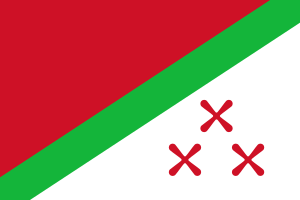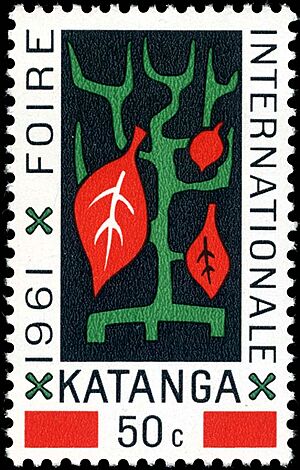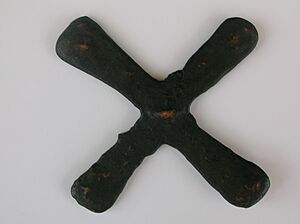History of Katanga facts for kids
This article tells the story of Katanga Province, a region in the Democratic Republic of the Congo. It also covers the history of the independent State of Katanga that existed there for a short time, and what the area was like before it became a colony.
Contents
First People to Live Here
Long, long ago, around 500 BCE, the Katanga area was likely home to Khoisan and Pygmy peoples. These groups were hunter-gatherers, meaning they found their food by hunting animals and gathering plants. Katanga is special because it's one of the few places in Africa where both groups lived at the same time. Later, the Bantu peoples moved into the area, and the Khoisan and Pygmy peoples either joined them or moved away.
Luba People Settle Down
The first groups to settle permanently in Katanga were likely the ancestors of the Luba people. They made their homes in the Upemba Depression, a marshy area near Lake Upemba. To live in the marshes, they had to work together on a large scale. They built dikes and ditches to drain the land. They also built dams to store fish, which was very important during the long dry season.
By the 8th century, the Luba people were skilled at working with iron. They also traded goods like salt, palm oil, and dried fish. They exchanged these items for copper, charcoal (used for melting iron), glass beads, iron tools, and cowrie shells from the Indian Ocean.
Over time, several different societies grew out of the Upemba culture. Each new society built upon the ideas and ways of life of the one before it. Around the 5th century, a new society developed near present-day Kamilamba. This was followed by other cultures centered around the cities of Sanga and Katango.
The Katanga region has lots of ores, which are rocks containing valuable metals. Because of this, these early civilizations learned to use iron and copper technology. They also traded ivory and other goods. The Upemba people created a strong demand for their metal products. They set up a simple but far-reaching trade network that stretched over 1,500 kilometers, all the way to the Indian Ocean. The region also had good conditions for farming and plenty of fish and game.
From the 1500s to the 1800s
Starting in the late 1500s, the Luba Empire and Lunda Kingdom controlled the Katanga province. Warriors and tribes from these kingdoms moved into nearby areas. Groups like the Bemba, Kazembe-Lunda, Kanongesha-Lunda, and Lozi in Zambia can trace their beginnings back to Katanga.
Msiri's Yeke Kingdom
In the mid-1800s, a trader named Msiri came from Tabora in what is now Tanzania. He founded a powerful but short-lived kingdom called the Yeke Kingdom. Msiri's home area was called Garanganza, and this name was also used for his kingdom. Msiri married the daughter of a chief named Katanga, who helped protect him. The name 'Katanga' actually comes from Msiri's father-in-law!
Msiri's power came from trading copper, ivory, and slaves. He traded these goods to both the west coast (Angola) and the east coast (Zanzibar) for firearms and gunpowder. This allowed him to become a warrior-king in just a few years. He took control of a large area, including land from the Luba and Lunda peoples.
In the 1880s, King Leopold II of Belgium set up the Congo Free State (CFS) north of Katanga. He heard about Katanga's rich copper and possible gold. Msiri tried to play Leopold's explorers against those of his rival, Cecil Rhodes. Leopold then sent the Stairs Expedition to claim Katanga by force if needed. Msiri did not cooperate, and he was shot by one of the expedition's European officers on December 28, 1891.
Belgian Colonial Rule
Leopold took control of Katanga. On April 15, 1891, he gave another of his companies, the Compagnie du Katanga, the job of managing it for the CFS. Real administration didn't start until June 19, 1900, when it was renamed the Comité Spécial du Katanga. This was a separate group from the CFS. The Luba people resisted this control, especially in a big rebellion in 1895. After this, many Luba were forced to work in the copper mines. Another Luba rebellion, led by Kasongo Nyembo, lasted until 1917.
After the Belgian government took over the CFS from Leopold on September 1, 1910, Katanga became part of the Belgian Congo. However, it kept a lot of autonomy (self-rule) until October 1, 1933. At that time, part of its Lomami Province was moved to Kasaï Province. On October 1, 1933, Katanga was renamed the province of Élisabethville, after its capital city (now called Lubumbashi).
Once Belgium had firm control, Belgian companies, especially Union Minière du Haut Katanga, heavily mined the area's mineral resources. Katanga developed much more than the rest of the country. These mining companies used hired guards to control the local people and ensure minerals were sent out of the country. The Luba people often opposed and interfered with mining operations, and many were killed in attacks on these operations.
Because of the high demand for workers in the mines, many people were brought in from nearby regions. Most were Luba people from the Kasai area, and some even came from Zambia.
Congo's Independence and Katanga's Breakaway
In June 1960, Congo became independent. Katanga then became an autonomous province. But on July 11, 1960, Katanga broke away from the new Congolese government led by Patrice Lumumba. Katanga declared itself an independent state under Moise Tshombe. He was the leader of a local party called the CONAKAT. However, Tshombe's new government didn't have support across the whole province, especially not in the northern Baluba areas.
Katanga's declaration of independence was supported by Belgian businesses and over 6,000 Belgian troops. Tshombe was known to be close to the Belgian industrial companies that mined the region's rich copper, gold, and uranium.
Katanga was one of the richest and most developed parts of Congo. Without it, Congo would lose a huge amount of its mineral wealth and government income. The Congolese central government and many international observers believed that Katanga's breakaway was a way to create a Belgian-controlled puppet state that would benefit mining companies. Even though Belgium helped Katanga militarily, it never officially recognized the new state. The Luba people were divided: one group supported the breakaway, and another supported the central government.
In September 1960, Lumumba was removed from power in a coup d'état. On January 17, 1961, he was sent to Lubumbashi, Katanga's capital, where he was executed shortly after arriving. Belgian officers, working under Katangese command, were present at the execution.
After Lumumba's death, the UN Security Council met. On February 21, 1961, they passed Resolution 161. This resolution allowed the UN to take "all appropriate measures" to stop civil war in Congo, including using force if absolutely necessary. It also demanded that all Belgian troops and foreign mercenaries leave Congo. UN forces in the area later used this resolution to justify military actions to end Katanga's breakaway. Despite this, the UN didn't start major military operations for six months. Instead, they focused on helping with political talks.
In June, Tshombe promised to reunite Katanga with the rest of Congo. However, by August, it was clear he didn't plan to keep his promise. In August and September, the UN tried twice to arrest and send home the mercenaries and political advisors by force. The second operation was met with resistance from the Katangese police, and people were hurt on both sides.
Peace talks followed. During these talks, UN Secretary-General Dag Hammarskjöld died in a plane crash near Ndola, Northern Rhodesia (now Zambia). The cause of the crash is still uncertain.
Under pressure from the UN, Tshombe later agreed to a plan from the acting Secretary General, U Thant, which would have reunited Katanga with Congo. But this agreement was never put into action.
Finally, urged on by Congolese leader Cyrille Adoula, UN forces launched a strong attack on Katanga in December 1962. The capital, Elisabethville (now Lubumbashi), fell in January 1963. Tshombe fled to Kolwezi, where he surrendered on January 15, 1963. The Katangese breakaway officially ended. Kisula Ngoye became the governor of the reunited province.
After Reunification
In 1966, the central government took control of the Union Minière du Haut Katanga, which is now known as Gécamines. In 1971, Katanga was renamed Shaba, which means 'brass' in the Swahili language. Throughout the 1970s, other rebellions, like the 1977 Shaba I, were stopped by the government with help from other countries. For example, on May 12, 1978, rebels took over the city of Kolwezi, a major mining center. Zaire (as Congo was then called) asked the United States, France, and Belgium to help restore order. This event led to many casualties.
In 1995, the African Commission on Human and Peoples' Rights looked at a complaint from the Katanga People's Congress. They claimed that Zaire had broken the international law principle of self-determination, which means people have the right to decide their own future. They asked the Commission to recognize Katanga's right to break away from Zaire.
The request was turned down. The Commission said it had to protect Zaire's territorial integrity (meaning its borders and unity). However, the Commission suggested that the people of Katanga might have a right to autonomy, which means some level of self-rule within the country.
The province became Katanga again in 1997 after Mobutu Sésé Seko was exiled. This was part of changing many colonial names back to their original ones.
According to the 2006 Constitution, Katanga was planned to be divided into four new provinces:
See also
- Lubumbashi history and timeline





